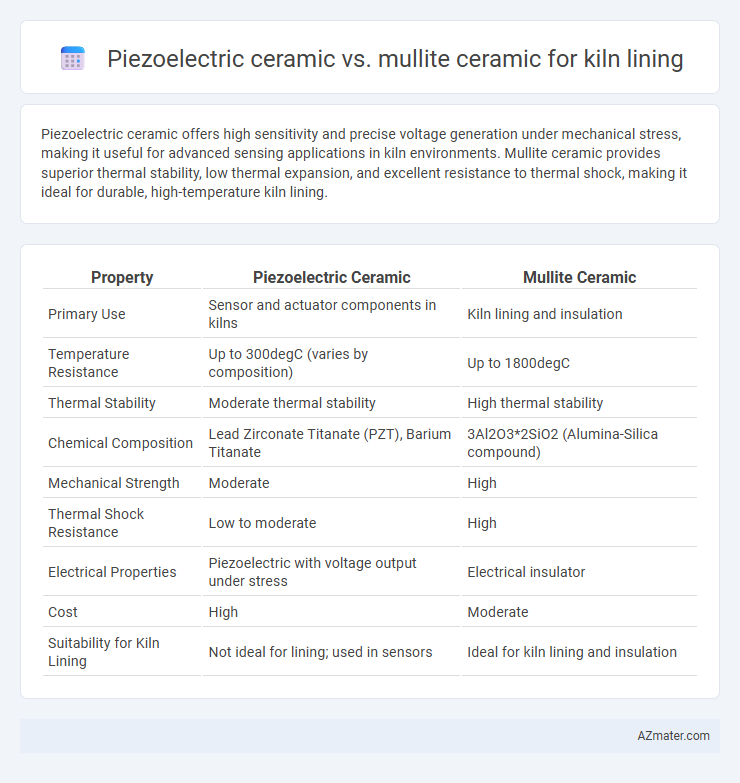Piezoelectric ceramic offers high sensitivity and precise voltage generation under mechanical stress, making it useful for advanced sensing applications in kiln environments. Mullite ceramic provides superior thermal stability, low thermal expansion, and excellent resistance to thermal shock, making it ideal for durable, high-temperature kiln lining.
Table of Comparison
| Property | Piezoelectric Ceramic | Mullite Ceramic |
|---|---|---|
| Primary Use | Sensor and actuator components in kilns | Kiln lining and insulation |
| Temperature Resistance | Up to 300degC (varies by composition) | Up to 1800degC |
| Thermal Stability | Moderate thermal stability | High thermal stability |
| Chemical Composition | Lead Zirconate Titanate (PZT), Barium Titanate | 3Al2O3*2SiO2 (Alumina-Silica compound) |
| Mechanical Strength | Moderate | High |
| Thermal Shock Resistance | Low to moderate | High |
| Electrical Properties | Piezoelectric with voltage output under stress | Electrical insulator |
| Cost | High | Moderate |
| Suitability for Kiln Lining | Not ideal for lining; used in sensors | Ideal for kiln lining and insulation |
Introduction: Importance of Ceramic Materials in Kiln Linings
Ceramic materials such as piezoelectric and mullite ceramics play a critical role in kiln linings due to their exceptional thermal stability and resistance to high temperatures. Piezoelectric ceramics offer unique electrical properties that can improve monitoring and control of kiln environments, while mullite ceramics are prized for their excellent mechanical strength and low thermal expansion. Selecting the optimal ceramic material enhances kiln durability and operational efficiency in industrial high-temperature processes.
Overview of Piezoelectric Ceramics
Piezoelectric ceramics, primarily composed of lead zirconate titanate (PZT), exhibit unique electromechanical properties that generate electric charge under mechanical stress, making them valuable in sensing and energy-harvesting applications. Unlike mullite ceramics valued for their thermal insulation and structural stability in kiln linings, piezoelectric ceramics are less commonly used as lining materials due to their brittleness and sensitivity to high temperatures. Their superior piezoelectric response and high dielectric constants distinguish them in advanced electronic components rather than refractory applications.
Overview of Mullite Ceramics
Mullite ceramics offer exceptional thermal stability, low thermal expansion, and high resistance to thermal shock, making them ideal for kiln lining applications where durability under high temperatures is critical. Their unique 3Al2O3*2SiO2 composition provides superior mechanical strength and excellent chemical inertness compared to piezoelectric ceramics, which primarily serve sensing and energy conversion roles. Mullite's low thermal conductivity and resistance to slag corrosion ensure prolonged kiln life and efficient heat retention, outperforming piezoelectric ceramics in refractory performance.
Physical and Chemical Properties Comparison
Piezoelectric ceramics exhibit high dielectric constants, excellent electromechanical coupling, and greater mechanical strength but have lower thermal stability compared to Mullite ceramics, which excel in high-temperature resistance and thermal shock durability due to their low thermal expansion coefficient and chemical inertness. Mullite ceramics offer superior resistance to oxidation, corrosion, and thermal degradation, making them ideal for kiln linings exposed to extreme environments. Piezoelectric ceramics, while structurally robust, lack the chemical inertness and high-temperature endurance necessary for prolonged kiln lining applications.
Thermal Stability and Heat Resistance
Piezoelectric ceramics exhibit moderate thermal stability but are generally less suited for high-temperature kiln lining compared to mullite ceramics, which offer excellent heat resistance and can withstand temperatures up to 1750degC without significant degradation. Mullite's low thermal expansion and high creep resistance ensure structural integrity and longevity in extreme thermal environments, making it ideal for kiln insulation. Conversely, piezoelectric ceramics tend to experience a decline in piezoelectric properties at elevated temperatures, limiting their application in sustained high-heat settings.
Mechanical Strength and Durability
Piezoelectric ceramics typically exhibit lower mechanical strength and durability compared to mullite ceramics, which are prized for their excellent thermal shock resistance and structural integrity in high-temperature kiln linings. Mullite ceramic's superior fracture toughness and resistance to spalling make it ideal for maintaining mechanical strength under prolonged thermal cycling. In contrast, piezoelectric ceramics' brittle nature limits their use in demanding kiln environments where long-term durability and mechanical stability are critical.
Performance Under Kiln Operating Conditions
Piezoelectric ceramics exhibit high sensitivity and stability under thermal cycling but are limited by lower thermal shock resistance compared to mullite ceramics. Mullite ceramics offer superior thermal stability, excellent resistance to thermal shock, and maintain structural integrity at kiln operating temperatures above 1400degC. The thermal conductivity and mechanical strength of mullite ceramics ensure more reliable performance for kiln linings subjected to rapid temperature fluctuations and prolonged high-heat exposure.
Cost and Availability
Piezoelectric ceramic exhibits higher cost due to its specialized material properties and complex manufacturing processes, making it less commonly used for kiln lining applications. Mullite ceramic offers superior availability and affordability, attributed to its abundant raw materials and well-established production methods in refractory industries. Cost-efficiency and widespread supply make mullite ceramic the preferred choice for kiln lining over piezoelectric ceramic.
Advantages and Limitations of Each Material
Piezoelectric ceramic offers high sensitivity and excellent electromechanical coupling, making it ideal for precise temperature and pressure control in kiln lining applications, but it is costly and can be brittle under mechanical stress. Mullite ceramic provides superior thermal stability, low thermal expansion, and excellent resistance to thermal shock, which ensures durability in high-temperature kiln environments; however, it lacks the sensing capabilities and piezoelectric properties needed for advanced monitoring. Choosing between these materials depends on prioritizing either functional sensing with piezoelectric ceramics or robustness and thermal resilience with mullite ceramics.
Conclusion: Best Choice for Kiln Lining Applications
Piezoelectric ceramics offer excellent sensitivity and durability but are less resistant to extreme thermal shock compared to mullite ceramics, which excel in high-temperature stability and thermal insulation. Mullite's low thermal expansion and superior thermal shock resistance make it the best choice for kiln lining applications where consistent performance under rapid temperature changes is critical. Therefore, mullite ceramic is the optimal ceramic material for durable, efficient, and stable kiln linings.

Infographic: Piezoelectric ceramic vs Mullite ceramic for Kiln lining
 azmater.com
azmater.com